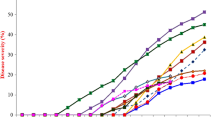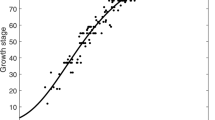Abstract
Gray leaf spot (caused by Cercospora sorghi Ellis & Everh.) is one of the most destructive foliar disease in fodder sorghum. Prediction model for gray leaf spot disease in fodder sorghum was developed based on 10-year (2010–2019) disease and weather data. It can occur during week-29 (third week of July) to week-43 (last week of October) in a year. Gray leaf spot had very strong, significantly negative correlation (r) with weekly average temperature (r = − 0.77), while moderate correlation was found with weekly average relative humidity (r = − 0.41), rainy days (r = − 0.44), sunshine hours (r = 0.35) and wind speed (r = − 0.36). Rainfall (r = − 0.29) and evaporation (r = − 0.23) had low correlation with gray leaf spot severity. Prediction model was developed using multiple regression coupled with goodness of fit statistics using R2 and Akaike information criteria (AIC). The prediction model included weekly average temperature, relative humidity and rainy days as predictor variables with R2 and AIC value of 0.70 and 819.03 respectively. The model was validated using leave one out cross validation (LOOCV) strategy and difference between observed residual root mean square error (RMSE) and as predicted using LOOCV was taken as indicator of model accuracy. Residual RMSE was 12.05 while that predicted through LOOCV was 12.46, indicating that model will perform fairly well on an independent data set. This prediction model can be used for efficient prediction to manage gray leaf spot disease of fodder sorghum.


Similar content being viewed by others
References
Airola A, Pahikkala T, Waegeman W, De Baets B, Salakoski T (2011) An experimental comparison of cross-validation techniques for estimating the area under the ROC curve. Comput Stat Data Anal 55:1828–1844
Akaike H (1973) Information theory and an extension of the maximum likelihood principle. In: Petrov BN, Caski F (eds) Proceedings of the second international symposium on information theory, Akademiai Kiado, Budapest, Hungary, pp 267–281
Allen DM (1971) Mean square error of prediction as a criterion for selecting variables. Technometrics 13:469–475
Allen DM (1974) The relationship between variable selection and data augmentation and a method for prediction. Technometrics 16:125–127
Annonymous, (2013) Forage crops and grasses. Handbook of Agriculture (sixth edition). Indian Council of Agricultural Research, New Delhi, pp 1353–1417. https://icar.gov.in/files/forage-and-grasses
Bhatia A, Munkvold GP (2002) Relationships of environmental and cultural factors with severity of gray leaf spot in maize. Plant Dis 86:1127–1133
Carisse O, McNealis V, Kriss A (2018) Association between weather variables, airborne inoculum concentration, and raspberry fruit rot caused by Botrytis cinerea. Phytopathology 108:70–82
Chaube HS, Singh US (1991) Plant disease management: principles and practices. CRC Press, Boca Raton, p 335
Dalmacio SC (2000) Target leaf spot. In: Frederiksen RA, Odvody GN (eds) Compendium of sorghum diseases, 2nd edn. American Phytopathological Society, St Paul, pp 16–17
De Wolf ED, Isard SA (2007) Disease cycle approach to plant disease prediction. Ann Rev Phytopathol 45:203–220
Del Ponte EM, Godoy CV, Li X, Yang XB (2006) Predicting severity of Asian soybean rust epidemics with empirical rainfall models. Phytopathology 96:797–803
Efron B, Tibshirani RJ (1993) An introduction to the bootstrap. Chapman and Hall, New York, p 430
Frederiksen RA (2000) Diseases and disease management in sorghum. In: Smith WC, Frederiksen RA (eds) Sorghum: origin, history, technology and production. Wiley, New York, pp 497–533
Frederiksen RA, Franklin D (1980) Sources of resistance to foliar disease of sorghum in the international disease and insect nursery. In: Williams RJ, Frederiksen RA, Mughogho LK, Bengtson GD (eds) Proceedings of the international workshop on sorghum diseases, Hyderabad, India, 11–15 December 1978, International Crops Research Institute for the Semi-Arid Tropics, Patancheru, Andhra Pradesh, India, pp 265–268
Henderson D, Williams CJ, Miller JS (2007) Forecasting late blight in potato crops of southern Idaho using logistic regression analysis. Plant Dis 91:951–956
Hughes G (2017) The evidential basis of decision making in plant disease management. Ann Rev Phytopathol 55:41–59
Jarroudi E, Kouadio M, Bock L, El Jarroudi CH, Junk M, Pasquali J, Maraite M, Delfosse H (2017) A threshold-based weather model for predicting stripe rust infection in winter wheat. Plant Dis 101:693–703
Joshi H, Kulkarni H, Deshpande S (2012) Multicollinearity diagnostics in statistical modeling and remedies to deal with it using SAS. In: SAS conference proceedings: Pharmaceutical users software exchange, October 14–17, 2012, Budapest, Hungary. Available via DIALOG. https://www.lexjansen.com/phuse/2012/sp/SP07.pdf. Accessed 15 Jan 2020
Koch S, Dunker S, Kleinhenz B, Rohrig M, von Tiedemann A (2007) A crop loss related forecasting model for Sclerotinia stem rot in winter oilseed rape. Phytopathology 97:1186–1194
Li Q, Pham H (2017) A testing-coverage software reliability model considering fault removal efficiency and error generation. PLoS One. https://doi.org/10.1371/journal.pone.0181524
Madden LV, Hughes G, van den Bosch F (2007) The study of plant disease epidemics. American Phytopathological Society St. Paul, USA, p 432
Marley PS, Elemo KA, Aba DA, Onu I, Akintayo I (2001) Reactions of sorghum genotypes to anthracnose and grey leaf spot under Sudan and Sahel savannah field conditions of Nigeria. J Sustain Agric 18:105–116
Mathur K, Bunker RN (2002) Drechslera leaf blight of sorghum caused by Dreschslera australiensis-new report from India. Int Sorghum Millets Newsl 43:60
Mehra LK, Cowger C, Ojiambo PS (2017) A model for predicting onset of Stagonospora nodorum blotch in winter wheat based on preplanting and weather factors. Phytopathology 107:635–644
Ngugi HK, King SB, Abayo G, Reddy YVR (2002) Prevalence, incidence and severity of sorghum diseases in Kenya. Plant Dis 86:65–70
Odvody GN, Hepperly PR (1992) Foliar diseases of Sorghum. In: de Millano WAJ, Frederiksen RA, Bengston GD (eds) Sorghum and millets diseases: a second world review. International Crop Research Institute for Semi Arid Tropics, Patancheru, pp 167–177
Okori P, Rubaihayo PR, Ekwamu A, Fahleson J, Dixelius C (2004) Genetic characterization of Cercospora sorghi from cultivated and wild sorghum and its relationship to other Cercospora fungi. Phytopathology 94:743–750
Pande S, Harikrishnan R, Alegbejo MD, Mughogho LK, Karunakar RI, Ajayi O (1993) Prevalence of sorghum diseases in Nigeria. Int J Pest Manag 39:297–303
Paul PA, Munkvold GP (2005) Regression and artificial neural network modelling for the prediction of gray leaf spot of maize. Phytopathology 95:388–396
Pham H (2006) System software reliability. Springer, London, p 437
Rooney LW, Waniska RD (2000) Sorghum food and industrial utilization. In: Smith CW, Frederiksen RA (eds) Sorghum: Origin, history, technology, and production. Wiley, Hoboken, pp 689–729
Smith DL, Hollowell JE, Isleib TG, Shew BB (2007) A sitespecific, weather-based disease regression model for Sclerotinia blight of peanut. Plant Dis 91:1436–1444
Van D Fels-Klerx, Burgers H, Booij SLGE CJH (2010) Descriptive modelling to predict deoxynivalenol in winter wheat in the Netherlands. Food Addit Contam 27:636–643
Witten IH, Frank E, Hall MA (2011) Data mining: practical machine learning tools and techniques, 3rd edn. Morgan Kaufmann, Waltham, p 664
Acknowledgements
The authors thank Indian Council of Agricultural Research (ICAR) for support through AICRP on Forage Crops and Utilization.
Author information
Authors and Affiliations
Corresponding author
Ethics declarations
Conflict of interest
The authors declare that they have no conflict of interest.
Additional information
Publisher's Note
Springer Nature remains neutral with regard to jurisdictional claims in published maps and institutional affiliations
Electronic supplementary material
Below is the link to the electronic supplementary material.
Rights and permissions
About this article
Cite this article
Bhardwaj, N.R., Atri, A., Rani, U. et al. Prediction model for gray leaf spot disease of fodder Sorghum. Indian Phytopathology 74, 61–67 (2021). https://doi.org/10.1007/s42360-020-00278-z
Received:
Revised:
Accepted:
Published:
Issue Date:
DOI: https://doi.org/10.1007/s42360-020-00278-z




